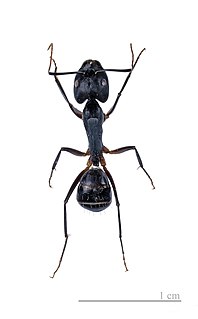
The Formicinae are a subfamily within the Formicidae containing ants of moderate evolutionary development.
Gesomyrmex curiosus is a species of ant in the subfamily Formicinae.
Gesomyrmex flavescens is a species of ant in the subfamily Formicinae.

Gesomyrmex germanicus is an extinct species of ant in the subfamily Formicinae known from an Eocene fossil found in Europe. G. germanicus is one of only eight species in the ant genus Gesomyrmex to have been described from fossils found in Europe.

Gesomyrmex pulcher is an extinct species of ant in the subfamily Formicinae known from an Eocene fossil found in Europe. G. pulcher is one of only eight species in the ant genus Gesomyrmex to have been described from fossils found in Europe.
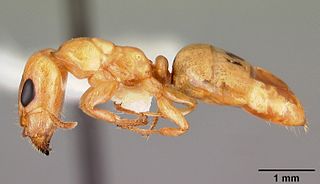
Gesomyrmex is a genus of ants in the subfamily Formicinae. The genus contains six extant species, known from the Indomalayan region, and nine fossil species. Of the extant species, four are known only from workers and two only from females. The extinct species "G. expectans" and "G. miegi", formerly placed in the genus, were excluded by Dlussky et al.., 2009.

Casaleia is an extinct genus of ants in the formicid subfamily Amblyoponinae described by Pagliano & Scaramozzino in 1990 from fossils found in Europe. The genus contains four species dating from the Eocene to Miocene, Casaleia eocenica, Casaleia inversa, Casaleia longiventris, Casaleia orientalis.

Pseudectatomma is an extinct genus of ants in the formicid subfamily Ectatomminae described by from fossils found in Europe. The genus contains two species dating from the Eocene, Pseudectatomma eocenica and Pseudectatomma striatula.

Pachycondyla eocenica is an extinct species of ant in the formicid subfamily Ponerinae described from fossils found in Europe. P. eocenica is one of six Lutetian Pachycondyla species.
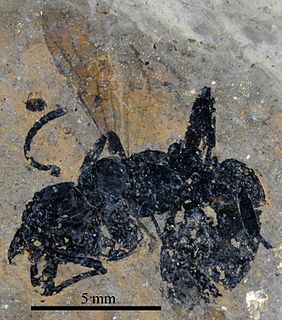
Pachycondyla lutzi is an extinct species of ant in the formicid subfamily Ponerinae described by from fossils found in Europe. P. lutzi is one of six Lutetian Pachycondyla species.
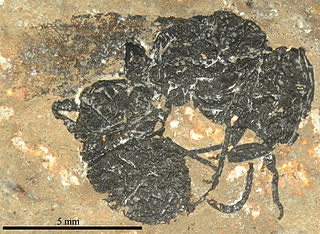
Pachycondyla? messeliana is an extinct species of ants in the formicid subfamily Ponerinae described by from a fossil found in Europe. P.? messeliana is one of six Lutetian Pachycondyla species.

Pachycondyla parvula is an extinct species of ant in the formicid subfamily Ponerinae described by from a fossil found in Europe. P. parvula is one of six Lutetian Pachycondyla species.

Pachycondyla petiolosa is an extinct species of ant in the formicid subfamily Ponerinae described by from a fossil found in Europe. P. parvula is one of six Lutetian Pachycondyla species.
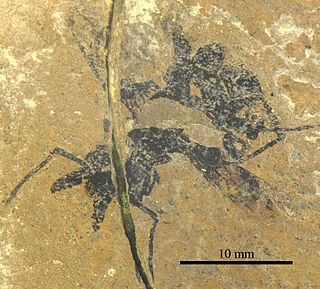
Cephalopone is an extinct genus of ants in the formicid subfamily Ponerinae described from fossils found in Europe. There are two described species placed into the genus, Cephalopone grandis and Cephalopone potens. Cephalopone is one several Lutetian Ponerinae genera.

Cyrtopone is an extinct genus of ants in the formicid subfamily Ponerinae described from fossils found in Europe. There are four described species placed into the genus, Cyrtopone curiosa, Cyrtopone elongata, Cyrtopone microcephala, and Cyrtopone striata. Cyrtopone is one several Lutetian Ponerinae genera.

Messelepone is an extinct genus of ants in the formicid subfamily Ponerinae described from fossils found in Europe. M. leptogenoides is the only species assigned to the genus, which is one of several Lutetian Ponerinae genera.
Gesomyrmex macrops is an extinct species of formicid in the ant subfamily Formicinae known from a fossil found in eastern Asia.
Gesomyrmex magnus is an extinct species of formicid in the ant subfamily Formicinae known from a fossil found in eastern Asia.
Gesomyrmex incertus is an extinct species of formicid in the ant subfamily Formicinae known from a fossil found in eastern Asia.














